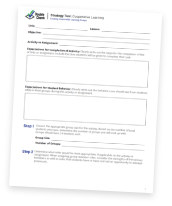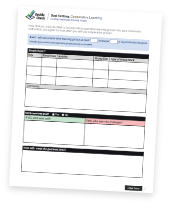Strategy: Cooperative Learning
Check-Up Menu > Cooperative Learning
Some key elements to effectively supporting cooperative learning:
How To
Not all classroom activities or assignments are optimal for cooperative groups. However, different types of activities can allow for different types of groups. In planning for incorporating groups into your classroom, consider what parts of your lesson will provide optimal opportunities for groups. Think about the activity and the objective you are trying to convey with the group work you have chosen. Consider what size groups would be best and also consider which students you will group together. Think about how to change the way you format and organize groups of students in order to ensure that all students have a chance to work with each other at some point.
There are several types of cooperative learning strategies that can be employed in the classroom. Below are just a few examples. Choose one of these strategies or use another one that you have found.
- Numbered Heads Together: Ask students to number off in their teams from one to four. Announce a question and a time limit. Students put their heads together to come up with an answer. Call a number and ask all students with that number to stand and answer the question. Recognize correct responses and elaborate through rich discussions (Kagan, 2009).
- Jigsaw: Students are placed into “home groups” and “expert groups” and are each assigned a different topic within the same general topic. Students work on researching their topics with others who have the same topic (their expert group) and then return back to their home group to teach them about their topic. Together, all the pieces come together to form a complete product (Reading Rockets, 2015).
- Turn & Talk: Sometimes called Think-Pair-Share. Students are put into pairs and provided with a question. Partners share their individual answers with each other. When time is up, the teacher calls on a student to share their partner’s response with the entire class.
- Gallery Walk: This strategy can be used to allow students movement and the ability to collaborate about ideas and discussion topics. The teacher puts a different question or topic on a large poster paper. The poster papers are placed around the room either hanging on the wall or sitting on various tables. Each group of students starts at one of the poster papers and works together to answer the question or to brainstorm about the topic. After a predetermined amount of time, students rotate around to the next poster and add to what the other groups have put on the poster. This continues until all groups have made it around to each poster. Once they return to their original poster paper, groups can then choose the best response and prepare to share with the class.
Strategy Tool

Reflection

Goal Setting

References to Other Relevant Resources:
Brame, C.J. and Biel, R. (2015). Setting up and facilitating group work: Using cooperative learning groups effectively. Retrieved from https://cft.vanderbilt.edu/guides-sub-pages/setting-up-and-facilitating-group-work-using-cooperative-learning-groups-effectively/
Curwin, R. L., Mendler, A. N., & Mendler, B. D. (2009). Discipline with dignity: New challenges, new solutions. Moorabbin, Vic.: Hawker Brownlow Education.
Emdin, C. (2016). Seven Cs for effective teaching. Educational Leadership, 74(1). Retrieved from http://www.ascd.org/publications/educational-leadership/sept16/vol74/num01/Seven-Cs-for-Effective-Teaching.aspx
Kagan, S. & Kagan, M. Kagan Cooperative Learning. San Clemente, CA: Kagan Publishing, 2009.
Markus, H. R., & Kitayama, S. (1991). Culture and the self: Implications for cognition, emotion, and motivation. Psychological Review, 98(2), 224-253.
Reading Rockets. (2015). Jigsaw. Retrieved from: http://www.readingrockets.org/strategies/jigsaw
Williams, J. L., & Hamm, J. V. (2018). Peer group ethnic diversity and social competencies in youth attending rural middle schools. Journal of Early Adolescence, 38(6), 795-823.